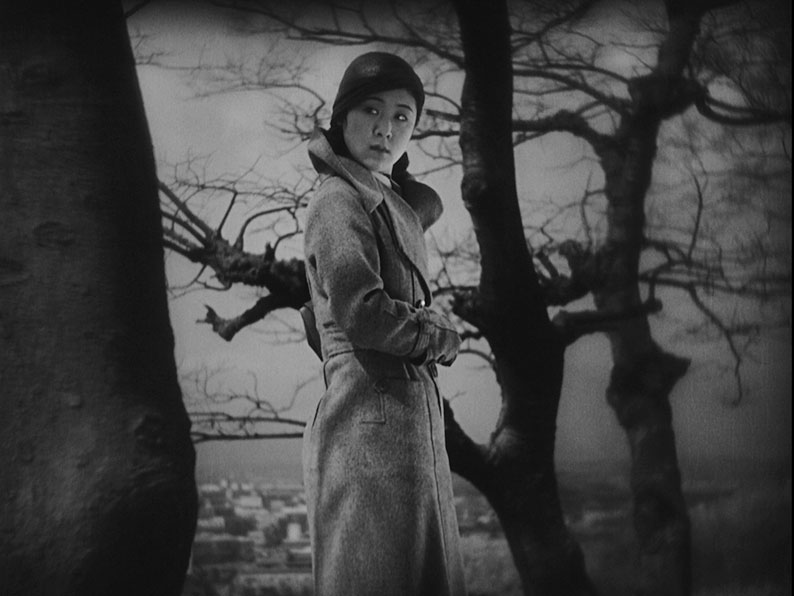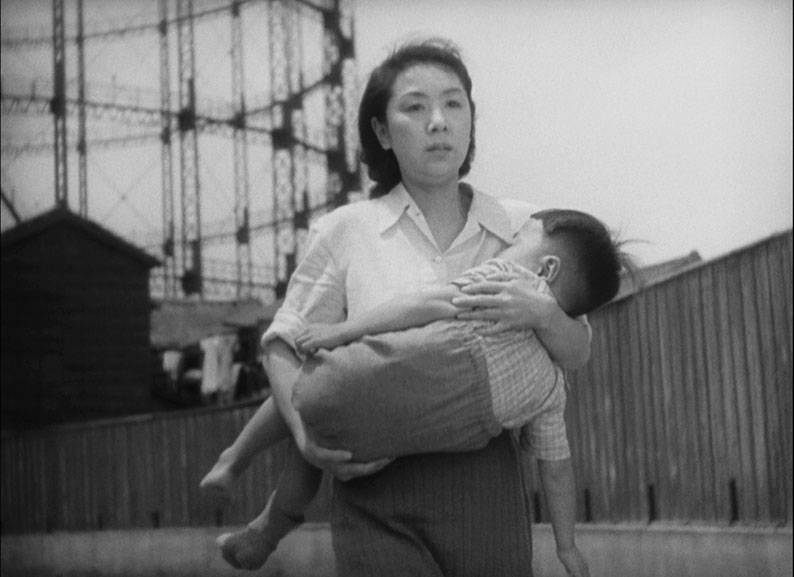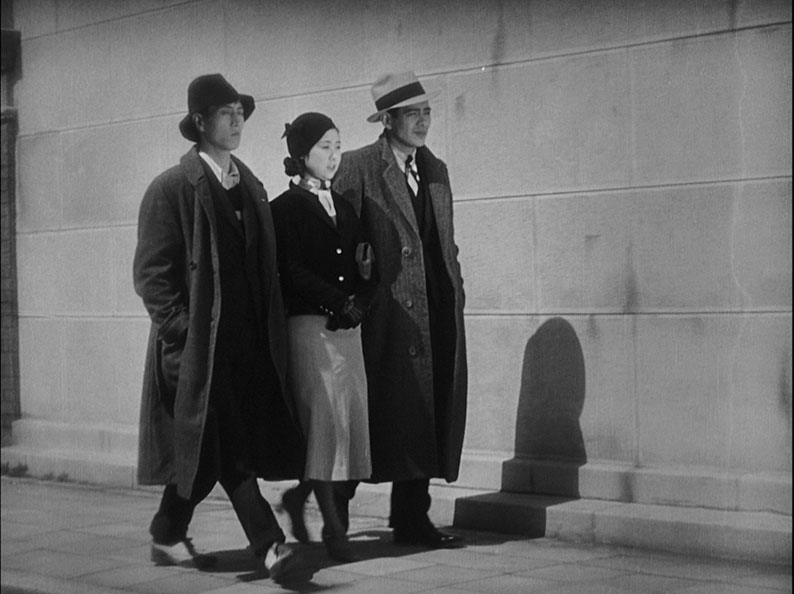|
Although the cinema began in Japan around the same time as other countries – the Lumière Brothers brought their films to the country in 1897 and the first locally-shot film, showing scenes of Tokyo, was made the same year – it's fair to say that much of the country's output remained obscure in the West for a long time. Akira Kurosawa's Rashomon was a breakthrough when it won the Golden Lion at Venice in 1951. However, other great directors, with similarly long careers, had to wait a while for recognition, possibly because they were more "Japanese" in style than the distinctly westernised Kurosawa. Yasujirō Ozu was one such, largely unknown in the West until Tokyo Story (Tōkyō monogatari) was screened in the UK in 1957, four years after it was made, winning the first-ever British Film Institute Sutherland Trophy. Ozu was prolific. If he wasn't a director who made more films than he lived years (which would have put him in the exalted company of, for example, Allan Dwan, Ford Beebe, Maurice Elvey, Rainer Werner Fassbinder and the still-active Takashi Miike), he wasn't far off: forty-nine features and four shorts and he died of cancer on his sixtieth birthday. However, a Sight & Sound article in 1963*, the year of Ozu's death, reckoned that of those fifty-four, just eight had been shown in the UK up to that point, with that year's London Film Festival about to make that nine, and none of them had been released commercially.

That's no longer the case. As I write, BFI Player offers fourteen Ozu films free with a subscription and another eleven available to rent (other streaming services are available), and much of the surviving parts of that filmography has been released on DVD and Blu-ray. Ozu's influence has been wide: you can see it in the work of his compatriot Hirokazu Kore-eda, for example. He has also been influential outside Japan. Notable Ozu devotees include Paul Schrader, who used him as one of the three directors studied in his 1972 book Transcendental Style in Film, along with Robert Bresson and Carl Theodor Dreyer. There are more than a few nods to Ozu in his 1985 film Mishima: A Life in Four Chapters, including the casting of Chishū Ryū (who acted in all but two of Ozu's films) in a small role. Wim Wenders also shows the influence of Ozu, and made a documentary about him, Tokyo-Ga (1985). Mike Leigh is another, having discovered Ozu's films at the National Film Theatre in the 1960s: see the barbecue scene in Secrets & Lies, staged in front of a lowish-angle fixed camera.
Ozu's style and techniques have been much written about. Unlike his contemporaries Kurosawa and Mizoguchi, his films all had contemporary settings, with the sole exception of his debut feature Sword of Penitence (Zange no yaiba, 1927), which is now lost. As his career developed, his films became family dramas or comedies, exploring interrelations between the generations. His filmmaking style was pared down over the years. He would often shoot with a fixed camera at a low angle, roughly equivalent to the eyeline of someone sitting on a tatami (floor mat), hence the term "tatami shot". Tracking shots and pans became rare. Conversations were often framed without the conventional eyelines that other directors might use, in Japan or elsewhere, with speakers often talking directly to camera. After his earliest films, Ozu eschewed such devices as dissolves, wipes and fades between scenes, simply using straight cuts, often opening a new scene on a close-up of an inanimate object (the so-called "pillow shot"). Dramatically the films were often minimalist, with what would be key events in other directors' work being elided or omitted entirely.
Sixty years after his death, Ozu's reputation is secure. In the 2022 Sight & Sound Greatest Films of All Time poll, he had two entries in the top hundred, with Late Spring (Banshun, 1949) at joint twenty-first and Tokyo Story at fourth. This BFI Blu-ray set comprises three of his films.
Ozu may have been prolific, but he was especially so in his early career. Dragnet Girl (Hijōsen no onna), made in 1933, was his twenty-eighth film, six years after his first. Although Japan had converted to sound around the same time as the West, with the first talkie feature being made in 1930, Ozu was one director who continued to make silent films until 1936. Of his thirty-four silents, nineteen are wholly or partially lost. Dragnet Girl is one which survives complete.
Written and directed by Ozu (the former role under the pseudonym James Maki), the film is a Japanese spin on a then-popular genre, the gangster movie. Tokiko (Kinuyo Tanaka) works by day in a typing pool in Yokohama but outside her job, her boyfriend is small-time hood Joji (Joji Oka). However, Joji now has eyes on Kazuko (Sumiko Mizokubo), the sister of another gang member. Tokiko is at first put out, but she develops a bond with Kazuko and decides to go on the straight and narrow…

Ozu was a fan of Hollywood cinema (you can see a French poster for All Quiet on the Western Front on a wall) and it's fair to say that Dragnet Girl offers us an Americanised fantasy version of then-contemporary Japan, with the gangsters using guns (in reality rarely used by Japanese criminals), much of the signage being in English, and there being coffee bars, nightclubs and pool halls, not to mention replicas of Nipper the HMV dog, more likely at the time to be found in the USA. Even the long row of typewriters at Tokiko's workplace was more of a western thing, as typewriters for Japanese script did not exist at the time, so Tokiko's typing work would have had to be material in English or another language using the Latin alphabet.
Another aspect of Ozu's films is his regard for his female characters, often found in traditional roles such as wives and mothers (or here, as a girlfriend), with their place in a patriarchal society often problematised by the stories of the films. Here, his film is enhanced by Kinuyo Tanaka, one of Japan's great screen actresses and later a noteworthy director, in her first of two roles in this box set.
The techniques Ozu developed are well advanced here, though several times he uses an intertitle to mark a transition between scenes. He also moves his camera more often than he later would. If the film is melodrama – with Tokiko trying to go straight and to bring Joji with her, the ending implying that this has redeemed her – it's an affecting one.
| RECORD OF A TENEMENT GENTLEMAN |
|
As the commentary and booklet essay in this release point out, for the benefit of those like me who are not Japanese-enabled, Record of a Tenement Gentleman (Nagaya shinshiroku) has a misleading English title. It's more accurately translated as Who's Who in the Tenement (there are more than one "gentleman" in the film), and "tenement" does not mean the same thing as it does in the UK. (A Japanese tenement is a row of low-rise wooden buildings, usually found in working-class areas.)

Record of a Tenement Gentleman (we're stuck with that English title by now) was made in 1947, Ozu's fortieth film and his first following World War II. Japan is a nation bearing the scars of the War, and under US occupation. The main characters live in an area of Tokyo still damaged by bombing raids. One evening, Tashiro (Chishū Ryū) brings home a young boy, Kōhei (Hōhi Aoki), who has become separate from his father and has followed Tashiro home. O-tane (Chōko Iida), a childless widow, reluctantly takes the boy in.
Although Ozu rarely if ever expressed political views, his friends included two fellow directors Sadao Yamanaka and Hiroshi Shimizu, both of whom were openly left-wing. Record of a Tenement Gentleman has a regard for the situation of his characters and their lives, with a small community working collectively. Post-War rationing is in force and they survive by bartering or looking for bargains. This is one of Ozu's shortest and simplest films, with the story motor being the growing bond between O-tane and Kōhei, awakening in the former maternal feelings she didn't know she had.
A Hen in the Wind (Kaze no naka no mendori) was Ozu's next film after Record of a Tenement Gentleman, made the following year. Ozu did not rate his own film particularly highly, but it won two awards (Best Actress for Kinuyo Tanaka and Best Art Direction for Tatsuo Hamada) at the Mainichi Film Concours, and Kinema Junpo (Japan's oldest film magazine, founded 1919) included it in their top ten for the year.
Tokiko (Kinuyo Tanaka with the same character name as in Dragnet Girl) lives with her young son. Her husband Shuichi (Shūji Sano) is away, yet to be repatriated after the end of the War. Tokiko struggles to make ends meet, working as a dressmaker. One day, her son falls in and is hospitalised, landing her with heavy bills. Following a suggestion by her friend Orie (Reiko Mizukami), she turns to prostitution for one night. Then Shuichi comes home…

Viewed now, A Hen in the Wind is notably ahead of its time, including prostitution and marital rape (both obliquely indicated) and domestic violence more directly with a startling scene towards the end of the film. The film is unusually structured, with the first two thirds squarely with Tokiko, the last third (after Shuichi returns, just under halfway through) largely with Shuichi as he struggles to understand what his wife has done, which leads him to find the brothel where Tokiko had worked, and he has a conversation with Fusako (Chiyoko Fumiya), a young prostitute. The film is complex: Shuichi tries to emphathise with his wife, though his actions are not to be condoned. On the other hand, Tokiko is accepting of her fate to the point of masochism. The film ends on a note of reconciliation, but you wonder what might happen in the future.
Three Films by Yasujirō Ozu is a two-disc Blu-ray release from the BFI, with Dragnet Girl on the first disc and the other two films on the second. The discs are encoded for Region B only. All three films have PG certificates. These are pre-existing certifications, and A Hen in the Wind might get a 12 if it were submitted to the BBFC now, for its depiction of domestic violence.
All three films were shot in black and white 35mm. The transfers of the three films ably distinguish between the silent-film ratio of 1.33:1 for Dragnet Girl and the Academy Ratio (1.37:1) of the two talkies, a ratio Ozu used to the end of his career. All three are transferred at 24 frames per second (to be precise, 23.976215 fps according to my player) and interestingly that appears to be the correct speed for the silent Dragnet Girl, as framestepping through the transfer reveals no duplicated frames. Most late silents, from the 1920s anyway and that I've seen, are 20fps, but maybe in 1933 Japanese cinemas showed everything at talkie speed, so as not to have to adjust their projector frame rate from one film to the next? If anyone has that kind of technical information, please let me know, but from watching it in motion, Dragnet Girl does appear to be at the right speed.
The transfers of the three films are derived from 4K restorations made in 2022 and 2023. There's a slight softness to Dragnet Girl, which may be inherent in its source (a 35mm print struck from the original nitrate negative), but it is otherwise detailed, with strong blacks and good detail in the often shadowy camerawork. Record of a Tenement Gentleman is less "dark" and is still a little soft in places, but blacks, whites and greyscale seems spot-on, and grain is natural and filmlike. Much the same could be said of A Hen in the Wind, though in darkness terms it's midway between the two.

The soundtracks are DTS-HD MA 2.0 in all cases, which plays in surround for Ed Hughes's string-quartet score for Dragnet Girl (recorded in 2012), and the intended mono for both sound films. These two films have a choice of soundtrack, restored and unrestored. I listened to both, and the unrestored versions have the full panoply of hisses and crackles and pops, but the sound does sound "warmer" than the restored versions, and are mixed rather louder. The restored tracks can sound a little flat, especially that of A Hen in the Wind. Otherwise, the tracks are clear, and representative of 1940s sound recording, with dialogue, music and sound effects well balanced. English subtitles are available for the Japanese dialogue of the second two films and the Japanese intertitles of the first. They are on by default, but if your command of spoken or written Japanese is up to scratch, you can switch them off.
Commentary on Dragnet Girl by Tony Rayns
The only on-disc extras on these discs are newly-recorded commentaries on each film. First up is Tony Rayns on Dragnet Girl. He says he won't spend much time discussing what's on screen, but gives us a wide-ranging commentary on the longest film in the set. He takes in the artificiality of the film's view of 1933 Yokohama and how it is a particularly "noisy" silent film. Ozu's devotion to Hollywood is discussed; Josef von Sternberg was the big-name American director in Japan at the time. (And of course von Sternberg made his final film, Anatahan, in the country.) As this is a late silent, we do get a brief history of Japan's transition to sound, and mentions a few cultural taboos. Kissing was one of them, so in such scenes Ozu conveys the joining lips with a shot of both pairs of feet close together. A very informative commentary. Incidentally, Rayns is the only one of the contributors to this set, in this commentary and his booklet essay, to render Japanese names in the Japanese order of surname first: so, for example, Ozu Yasujirō.
Commentary on Record of a Tenement Gentleman by Jasper Sharp
For Record of a Tenement Gentleman, we have another specialist in Japanese cinema, Jasper Sharp. He begins by pointing out a surprising piece of occupation-era censorship: production company Shochiku's usual Mount Fuji local has been replaced. The reason for this is that direct references to the War and the American occupation were banned, and also nationalist symbols like the famous mountain. That said, Ozu got the statue of the samurai Saigo Takamori, featured prominently in the final scene past the censors. As this is the shortest film in the set, you do wonder at times if Sharp is going to run out of time, but he doesn't, and there's a lot packed in.
Commentary on A Hen in the Wind by Adrian Martin
Adrian Martin's commentary on A Hen in the Wind is rather different. It overtly draws on academic books and essays, especially David Bordwell's 1988 book Ozu and the Poetics of Cinema. There is a lot of discussion of Ozu's techniques, particularly the use of eyelines referred to above. There are also mentions of recurring shots, such as the staircase setting up a climactic scene. As such this is a denser commentary than others, but it's a worthwhile listen.

Booklet
The BFI's booklet, available with the first pressing of this release, runs to twenty-eight pages. The essays, with a warning for possible spoilers, begin with Bryony Dixon on Dragnet Girl. She points up the resemblance to American gangster films, particularly that to another silent, Japanese favourite Josef von Sternberg's Underworld. The speed of the film's production – this was Ozu's second of three films to be released in 1933 – does show in some technical lapses, but Dixon does call attention to the precision of Ozu's plotting and developing film language.
Tony Rayns returns, here with an essay on Record of a Tenement Gentleman. He begins by referring to the film's misleading English title. Rayns discusses the film's production – written in fourteen days and largely shot in the studio, with some location work. He also talks about the social concerns of the film, and the way this allied the usually apolitical Ozu with his leftist filmmaking friends Yamanaka and Shimizu.
Next is Jonathan Rosenbaum on A Hen in the Wind, who begins by referring to Ozu's lack of regard for his own film and the dismissiveness of some Ozu commentators, but it has also had its defenders, and Rosenbaum is one of them. He also discusses the film's use of its locations (including Tokiko and Shuichi's squalid home) and suggests that instead of being the most Japanese of directors, Ozu could have been one of the least, not only because of his love for Hollywood films, posters for which can often be seen on walls.
The booklet also has a piece by Ed Hughes on his approach to the score for Dragnet Girl and other Ozu gangster films, plus biographies of the musicians, who are the Belvedere Quartet: Susanne Stanzeleit (first violin), Marina Gillam (second violin), Gustav Clarkson (viola) and Andrew Fuller (cello), with Patrick Bailey as musical director. Also in the booklet are notes on the extras and the transfers, full credits for each film, and plenty of stills.
Sixty years after his death, Yasujirō Ozu has gone from being hardly known in the West to being recognised as one of the world's great directors, his place secure and his influence widespread. There are a lot of films that could be released, and with many of the major classics released elsewhere, some by the BFI, this box set does well by three of the lesser-known works in his filmography. There is certainly scope for future volumes.
|